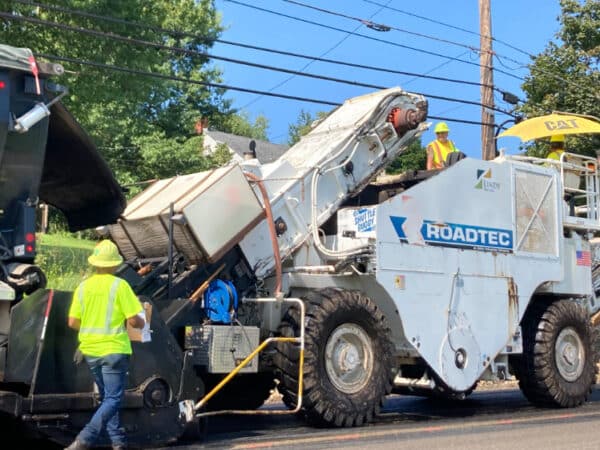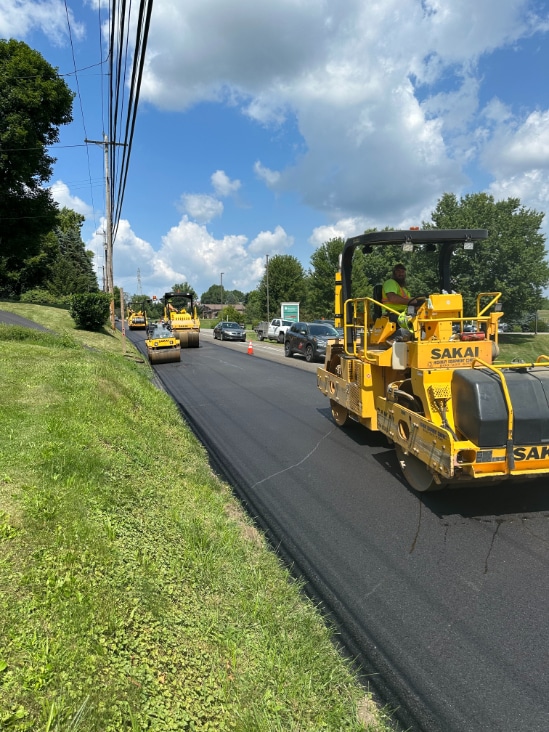Lindy and Penn State Pilot Rejuvenators
BY Sandy Lender

Lindy Paving Inc., headquartered in New Galilee, Pennsylvania, often leads the way with projects and practices in the state. In many cases, the company uses higher recycled asphalt pavement (RAP) contents compared with the widely publicized national average of 21.3%. To test extending such use even further without sacrificing pavement performance, Lindy Paving partnered with the Northeast Center of Excellence for Pavement Technology (NECEPT) at Pennsylvania State University’s Larson Transportation Institute to start a research project investigating application and performance of high RAP mixes blended with rejuvenating agents—also referred to as recycling agents (RAs).
Mansour Solaimanian, Ph.D., P.E., is the director and research professor at NECEPT, and he shared that NECEPT is experienced in conducting asphalt related research projects, especially with the use of recycling materials, and the reason Lindy selected Penn State to partner with. He explained the pilot project discussed herein is mutually sponsored by Lindy Paving and the U.S. Department of Transportation (USDOT) Region 3 University Transportation Center.

Each day’s roller pattern saw all three large rollers performing two passes—for a total of six vibratory—and one static. The shoulder roller performed its two passes in vibratory mode. On the third day of paving—with the 35% RAP mix dosed with Ingevity’s CA-9—this resulted in an average mat density of 95.8%. Photo courtesy of Ingevity
In August 2023, the pilot project was placed on State Route 4018 (SR 4018) by Lindy Paving. Martin Libertini, the daily plant quality control manager for Lindy, stated that Pennsylvania Department of Transportation (PennDOT) District 11 found the road that would make a good candidate for the project. He described it as a “perfect scenario for this mix design.” For the state route with all its curves, driveways, hills, hospital entrance, school zone, sewer inlets, side roads, and potential for water intrusion, Lindy and Penn State worked with Ingevity Road Technologies, headquartered in North Charleston, South Carolina, and Cargill, headquartered in Wayzata, Minnesota, to test a 35% RAP mix dosed with RAs.
“It’s a tough one because it’s a low-volume road, but there’s a hospital and a school,” Libertini said. “Kevin Gnegy with PennDOT developed a provisional spec with the help from Mansour’s past experience in research with RAs. Kudos to PennDOT for making this all possible. We couldn’t have asked for a better scenario for this research project.”
Building on Knowledge
This project occurred after a successful October 2022 RAs research project with PennDOT in conjunction with Penn State offered optimism from a lab setting. The study titled “Evaluating Testing, Protocols, and Limits for Asphalt Rejuvenating Agents in PA” focused on in-depth lab testing of various recycling agents, recycled asphalt materials and virgin materials.
Kevin Gnegy, P.E., pavement materials engineer with PennDOT, shared that the 2022 study was useful, but didn’t include a field component to study ARs. “Yes, we saw improvement,” he said. “We know they can work, at least in laboratory settings.” No field study was included with the 2022 research project. “It was basically to identify what can rejuvenators do, what percentages can we go up to with recycled agents and in different combinations. We did see improvement in the performance testing of the asphalt mixtures in the laboratory in regard to crack resistance and rutting performance.”

The Lindy Paving team produced 1,200 tons of a control mix with 15% RAP and Sonnegreenas IV at a 0.25% dosage rate at its Koppel Plant for the first day of paving, Aug. 8. Daily Plant Quality Control Manager Martin Libertini shared that the Neville Island plant is in the research project plans, so switching production of the dosed mixes to the Neville facility merely required a few more haul trucks. Photo courtesy of Ingevity
The project in August 2023 took recycling agents to the field with a veteran contractor at the helm.
Gnegy said this pilot showed promise for use of recycling agents with higher RAP mixes. He acknowledged that a concern with higher recycled materials in asphalt mixes is mobilizing the asphalt and offsetting the oxidized and embrittled properties from the recycled asphalt binder. RAs are designed to aid the completed mix from becoming too brittle, thus prone to premature cracking. Dosages of the RAs vary by manufacturer, RAP and virgin mix properties, he shared, thus using balanced mix design (BMD) performance testing can help balance the right amount of RAP, RAs and virgin materials to address the cracking concern while still providing rut resistance.

“Guys in the field noticed how tight of a mat both mixes produced and how smooth the material flowed in the MTV and paver,” Eric Yauger said. Photo courtesy of Cargill
Gnegy sees this opportunity to partner with industry and pilot RAs fruitful for PennDOT in evaluating beyond lab testing; it could assist with implementation of RAs in Pennsylvania pavements. Gnegy added: “Utilizing higher recycled materials could reduce the cost of asphalt mixtures and be environmentally beneficial.”
The Project Equipment and Specs
SR 4018 is also known as Dutch Ridge Road—a two-lane road of 11-foot-wide lanes with 1-foot shoulders. The team tackled a 4-mile section in Beaver County. For each day of paving—with the control mix or dosed test mixes—the crew used a 10-foot CAT AP105E paver with an Extend-A-Mat 10-20B screed fed by an Astec 1500D material transfer vehicle (MTV). “The 1500 was specified in our contract,” Project Manager Eric Yauger shared. For compaction, they had a Sakai SW 800-II in the breakdown position; a Sakai SW 774 for intermediate rolling; a Sakai SW 800-II for finish; and a Sakai 320-1 to get the shoulders. They had a CAT AP1055E paver and Sakai SW 774 (intermediate roller) on hand for backup.

SR 4018 is also known as Dutch Ridge Road—a two-lane road of 11-foot-wide lanes with 1-foot shoulders. The Lindy team tackled a 4-mile section in Beaver County. Photo courtesy of Cargill
“We kept backup equipment close in case of any breakdowns,” Yauger explained. “Traffic control was a challenge because of the narrow, winding roadway along with the hospital in the middle of the job and many driveway/side roads. We kept our work zone tightly spaced to help keep traffic moving. Also utilized flowboys because of the trees and power lines.”
As all good science does, the demo project began with a control section.

Each day’s roller pattern saw all three large rollers performing two passes—for a total of six vibratory—and one static. The shoulder roller performed its two passes in vibratory mode. On the second day of paving—with the 35% RAP mix dosed with Cargill’s Anova 1815—this resulted in an average mat density of 94.9%. Photo courtesy of Cargill
On Tuesday, Aug. 8, 2023, the team produced at its Koppel plant—a Gencor Ultradrum that ran between 350 and 400 tons per hour (TPH)—a control mix with 15% RAP. This mix used Sonnegreenas IV warm mix additive at a 0.25% dosage rate, according to Lindy’s Martin Libertini, who was on site. The paving crew, under the supervision of Yauger, placed 1,200 tons on the southbound lane that day with 12 trucks hauling about 20 minutes from the plant.
Sonnegreenas IV is an organic wax additive from All States Materials Group®.
On Wednesday, Aug. 9, the team produced at the Neville Island plant—a Gencor plant that ran at 450 TPH—a 35% RAP mix dosed with Cargill’s Anova® 1815 rejuvenator. This one also used Sonnegreenas IV warm mix additive at a 0.25% dosage rate and included the Anova 1815 at 1.3% of virgin AC. The paving crew placed between 1,140 to 1,200 tons on the southbound lane that day with 15 trucks hauling about 45 minutes from the plant.

On the third day of paving, the crew places a gorgeous mat with a 35% RAP mix dosed with CA-9. Photo courtesy of Lindy Paving
The team got rained out on Thursday.
On Friday, Aug. 11, the team produced at the Neville Island plant a 35% RAP mix dosed with Ingevity’s Evoflex CA-9 rejuvenator. This one also used Sonnegreenas IV warm mix additive at a 0.25% dosage rate and included the CA-9 at 1.3% of virgin AC. The paving crew placed 1,200 tons on the northbound lane that day with 15 trucks hauling 45 minutes from the plant.
The Project Observations
On the first day, the team took 5-gallon bucket samples from the back of haul trucks as well as behind the paver for Ingevity’s Tulsa lab and for Penn State University’s lab to collect data on the control mix. There, technicians performed all volumetric testing, HWTT, IDEAL-CT Index testing and binder aging. Ingevity’s Dominic Barilla shared. That day’s roller pattern saw all three large rollers performing two passes—for a total of six vibratory—and one static. The shoulder roller performed its two passes in vibratory mode. This resulted in an average mat density of 94.6% for the day.

The shoulder roller performed its two passes in vibratory mode.
On the second day, to produce the 35% RAP mix with the Cargill rejuvenator added in, the Lindy production team injected Anova 1815 with the liquid AC at the drum at a rate of 1.3% of virgin AC. “Lindy is very well-versed in additives, and they have a manifold set up for this,” Cargill Commercial Manager Steve Haughton said. The team took 5-gallon bucket samples from the back of haul trucks as well as behind the paver for Cargill’s lab and for Penn State University’s lab to collect data on the Anova 35% RAP mix design. The plant held production temperatures around 290-305°F, Haughton said, with mix holding a temperature around 290°F behind the paver after a haul of 45 minutes. The rolling pattern remained the same as it was for the first day’s control mat and the team didn’t have to make any changes with the increased RAP in the asphalt mix, resulting in an average mat density of 94.9%.

The shoulder roller performed its two passes in vibratory mode.
On the third day of paving, to produce the 35% RAP mix with the Ingevity rejuvenator added in, the Lindy production team injected Evoflex CA-9 at the drum at a rate of 1.3% of virgin AC. The team took ten 5-gallon bucket samples from the back of haul trucks as well as behind the paver, plus a bucket of RAP and an AC sample, for the Tulsa lab and for Penn State University’s lab on the third day of paving, according to Barilla. There, technicians performed all volumetric testing HWTT, IDEAL-CT Index testing and binder aging. The plant held production temperatures around 300-310°F, according to Barilla, with mat temperatures behind the paver between 285 and 300°F after a haul of 45 minutes. The rolling pattern remained the same as it was for the first day’s control mat and the team didn’t have to make any changes with the increased RAP in the asphalt mix, resulting in an average mat density of 95.8%.
Lindy’s Yauger noted that the whole team worked in harmony to incorporate the different elements for the pilot. “Change in mixes was seamless on our end other than adding the additional trucking out of Neville in lieu of Koppel,” he shared. “Everyone was a part of the schedule to help with coordination with other projects. Since N.I. was further and had potential for traffic delays, we adjusted our paving speed to accommodate and added additional trucks. We set up a full day’s production for each mix to eliminate any need to switch materials.”

The team got rained out on the tenth of August, but the team didn’t let moisture impact production temperatures overmuch. Best practices in working stockpiles and material delivery played a role in feeding consistent material to the plant. Photo courtesy of Ingevity
Working with a Seasoned Contractor Brings Success
One way to ensure mat smoothness is the best practice of keeping the paving train moving. Yauger shared how the seasoned team accomplished this. “Keys to keeping the paver moving were excellent traffic control, the continuous flow of material from the plants with constant communication, adequate amount of trucks, utilizing a material transfer vehicle, sufficient paver speed and amount of rollers to keep up.”
When comparing the control mix to the higher RAP mixes with RAs, the team saw no difference in mix workability and rolling effort on the curvy hilly surface, there was no shoving or pushing, Libertini confirmed. This project had a high amount of handwork and detail work; the crew accomplished this successfully on both mixes, he said.

Here we can see evidence of one more obstacle the Lindy Paving work zone safety crew handled—managing trucks and paving through a school zone. Photo courtesy of Ingevity
Yauger’s team on site agreed: “Guys in the field noticed how tight of a mat both mixes produced and how smooth the material flowed in the MTV and paver,” he said.
A tight paving train kept more than final smoothness in line. Haughton noted the way the team worked around physical challenges. Yauger commented earlier on the interruptions in the work zone—interruptions like a hospital entrance and side roads. Best practices and safety protocol worked hand in hand for this success.
With Penn State University working on grant funding to assess the viability of rejuvenator use, this pilot project could provide valuable data for researchers. Not only has Lindy Paving shown best production practices, but they’ve also shown best paving and safety practices along the way. PennDOT’s Gnegy sees next steps involve creating and establishing test methods to validate the performance of various rejuvenating agents and establish long term performance testing criteria and protocols to advance this technology in Pennsylvania.
